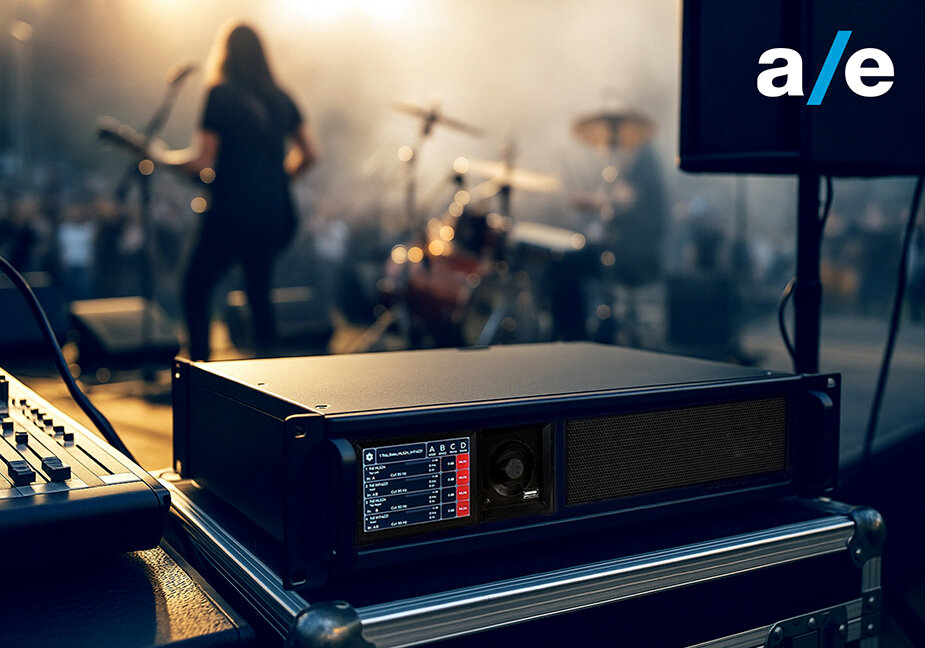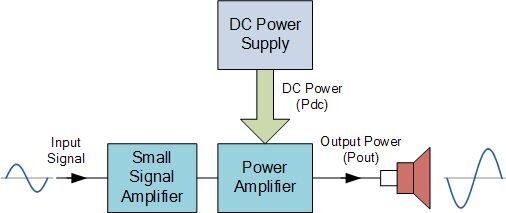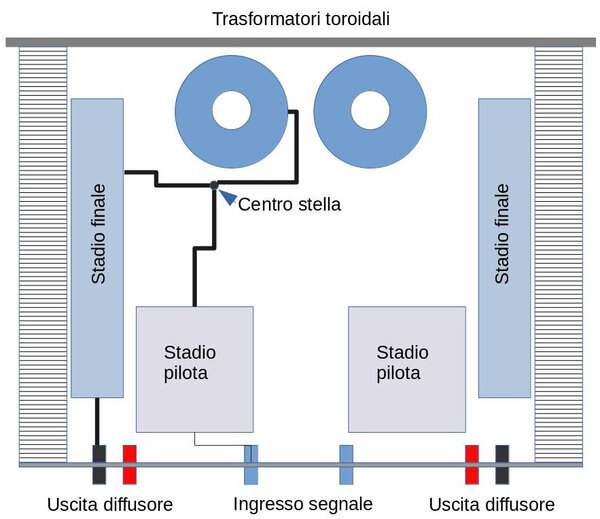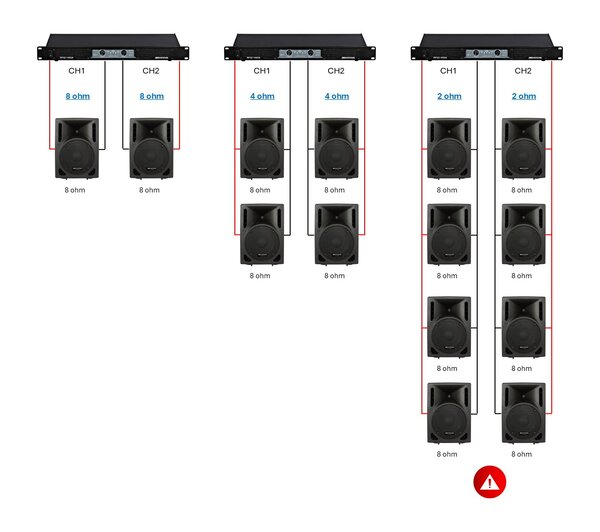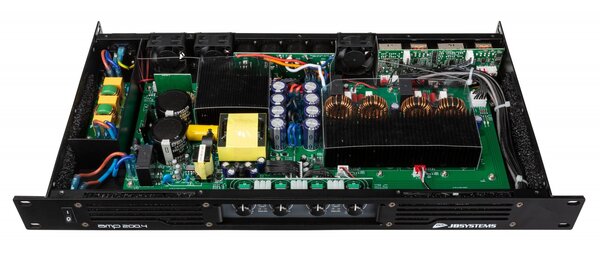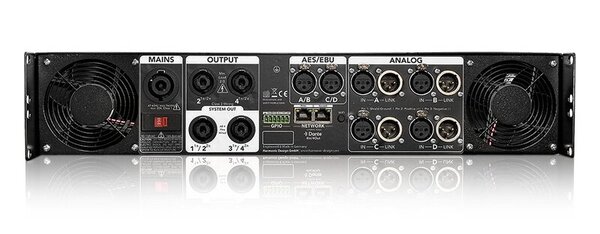Alongside loudspeakers, power amplifiers form the core of any PA system: they drive the speakers and largely determine both sound quality and overall audio system performance. Choosing the right amplifier depends on multiple factors, including the number of channels, output power, amplifier class (and thus efficiency), build quality, and versatility. Audio Effetti offers a wide range of power amplifiers designed to withstand even the most demanding conditions, such as those found in touring events.
From a strictly technical perspective, an amplifier is essentially a "black box" that receives a low-power audio signal and outputs a high-power signal naturally at the cost of increased energy consumption. It’s already clear how many different types of amplifiers the pro audio market can offer.
The diagram below shows a simplified block diagram of an integrated amplifier. The section labeled Small Signal Amplifier is actually the preamplifier, while this article focuses exclusively on the Power Amplifier the final output stage.
Power amplifiers typically come in 2-channel (e.g., elokance HA 1600) or 4-channel (e.g., Definitive Audio QUAD 150D) configurations, each corresponding to a low-impedance output.
Some 2- and 4-channel models can operate in bridged mode, effectively turning them into mono or stereo amplifiers capable of delivering twice the power an often-useful feature when driving subwoofers, for example.
Amplifiers are modular by design, meaning each channel replicates the same circuitry, although different power stages can be used depending on system requirements.
A typical stereo amplifier layout viewed from above shows heat sinks on either side, thermally connected to the power transistors or MOSFETs.
Basic and more affordable amplifiers usually have a minimal front panel, offering gain controls for each channel and a series of LEDs indicating overload, signal presence, or other statuses.
For instance, the Audiophony Ti300 provides 2 x 150 WRMS at 4 ohms.
The load impedance issue
Live concerts often require numerous loudspeakers think of the number of line array modules or subwoofers making it necessary to use several amplifiers, always within their rated power output, which is directly related to load impedance.
Let’s say you have a stereo amplifier: every time you connect two additional identical speakers in parallel to the outputs, the load impedance seen by the amplifier is halved for example, from 8 to 4 ohms. Ideally, this would double the output power, but in reality, it increases by less than that due to power supply limitations.
Adding more speakers in parallel further lowers the impedance, eventually approaching a short circuit. At this point, the amplifier cannot continue delivering power indefinitely and will trigger its internal protection systems. For this reason, when planning to connect multiple speakers to one amplifier, it's advisable to use high-impedance speakers, e.g., 16 ohms, whenever possible, or opt for multi-channel amplifiers, or both.
This is also one of the main reasons why 100V distributed sound systems are widely used in fixed installations (though not in these live scenarios).
Power alone is not a meaningful figure unless it’s related to speaker efficiency, i.e., the SPL output achieved with 1 watt at 1 meter. More efficient speakers require less power, and vice versa. Keep in mind: every 3 dB drop in efficiency means you need to double the amplifier power to achieve the same SPL.
Amplifier classes
One of the most common specifications provided by manufacturers is amplifier class. This describes how the transistors in the output stage handle and amplify the audio signal. Without diving too deep, Class-A amplifiers offer the best performance and lowest distortion but are mostly used in high-end hi-fi due to their low efficiency, high heat generation, and cost.
There are also Class AB, B, H, etc., but the one most relevant in professional audio is Class-D.
A Class-D amplifier, also known as a switching amplifier, converts the analog input signal into a PWM (Pulse Width Modulated) signal a sequence of pulses that represent the input's amplitude and frequency. This PWM signal is then amplified and passed through a low-pass filter to restore the original audio waveform and eliminate ultrasonic artifacts before reaching the speakers.
The internal view of the JB Systems AMP200.4 shows a Class-D architecture.
The main advantage of Class-D amplifiers is their high efficiency, often around 90% significantly higher than the 50–70% typical of Class AB designs. This means nearly all the electrical energy is used for amplification. For this reason, Class-D technology is dominant in the professional market: it allows high output power often several thousand watts per channel in a compact format. In some cases, this even eliminates the need for heat sinks and cooling fans.
Today, nearly all professional power amplifiers except for a few specific applications utilize Class-D circuitry.
The DSP revolution
More advanced and high-end models increasingly integrate DSP (Digital Signal Processing). As indicated in the block diagram as Processor, the DSP performs a wide range of audio processing functions: equalization, compression, expansion, limiting, filtering, delay, etc. To do this, the input signal must first be converted from analog to digital via an A/D converter.
With DSP, internal memory can store speaker presets and libraries, allowing you to configure the amplifier for each loudspeaker model with maximum accuracy and without time-consuming manual calibrations. The benefits of onboard DSP include frequency response linearization, improved dynamic range, better signal-to-noise ratio, and above all, more precise and flexible control particularly important when managing subs and satellite speakers separately.
One such amplifier is the Harmonic Design QT12ETH, a Class-D unit with DSP and IIR/FIR filters, delivering 4 x 3000 WRMS at 4 ohms.
The hd MultiDSP in this amplifier combines IIR and FIR filters to generate perfectly linearized phase curves and significantly improved impulse responses for a more natural, transparent, and realistic listening experience.
Connections and protection features
On the rear panel of an amplifier, you'll find connectors for both line-level audio input and speaker output. Inputs range from unbalanced RCA (common in consumer gear) to more professional and safer XLR female or combo XLR/jack balanced connectors.
Speaker outputs typically use speakON connectors, and occasionally screw terminals or banana plugs.
A single speakON power connector can carry up to two channels, and thanks to its bayonet-locking system, it offers secure and fast connections crucial in major live events where dozens or even hundreds of amplifiers may need to connect to corresponding line array modules and subwoofers.
More and more often, you’ll also find RJ45 network ports used for remote control in DSP-equipped models or for receiving audio over a Dante network. For example, the aforementioned Harmonic Design QT12ETH, as well as its sibling QT8ETH (4 x 2000 WRMS at 4 ohms), feature an Ethernet port that connects also via Wi-Fi through an access point to the proprietary hd LevelZ software suite. This enables full system planning, simulation, control, and fine-tuning of Harmonic Design loudspeakers from compact 2.1 setups to large-scale sound reinforcement systems. In addition to 4 analog inputs, these models also offer AES3 and Dante digital inputs.
Power amplifiers include multiple protection systems to ensure safe and reliable operation. Key among these is thermal protection, which activates if internal temperatures exceed safe levels, preventing component damage. Short-circuit protection is equally essential, safeguarding the output stage in the event of faulty speaker cables or drivers.
DC protection is critical: if a malfunction causes a direct current output, it can severely damage connected speakers. To prevent this, many amplifiers automatically disconnect the load in such cases. Overvoltage and overcurrent protections guard against power spikes, while soft-start circuits avoid inrush current surges during power-on.
An amplifier like the Synq PE-2400, for instance, features an automatic output current limiter and protection against short circuits, DC faults, overheating, and overload conditions.
Want to learn more?
Email us at international@audioeffetti.it

 English
English  French
French
